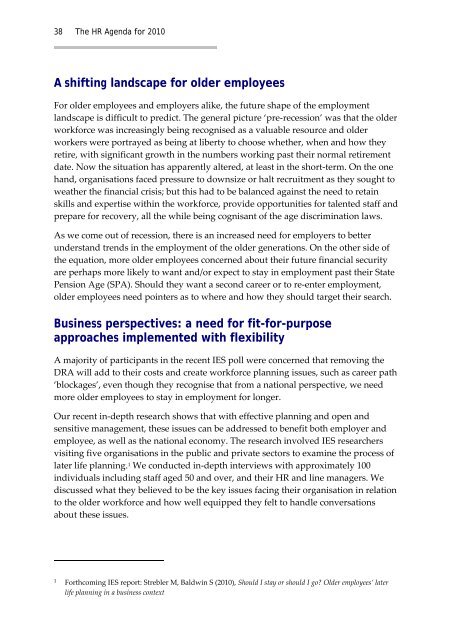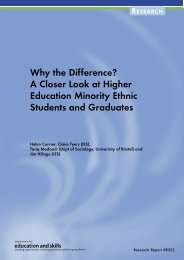PDF of this item - The Institute for Employment Studies
PDF of this item - The Institute for Employment Studies
PDF of this item - The Institute for Employment Studies
- No tags were found...
Create successful ePaper yourself
Turn your PDF publications into a flip-book with our unique Google optimized e-Paper software.
38 <strong>The</strong> HR Agenda <strong>for</strong> 2010A shifting landscape <strong>for</strong> older employeesFor older employees and employers alike, the future shape <strong>of</strong> the employmentlandscape is difficult to predict. <strong>The</strong> general picture ‘pre‐recession’ was that the olderwork<strong>for</strong>ce was increasingly being recognised as a valuable resource and olderworkers were portrayed as being at liberty to choose whether, when and how theyretire, with significant growth in the numbers working past their normal retirementdate. Now the situation has apparently altered, at least in the short‐term. On the onehand, organisations faced pressure to downsize or halt recruitment as they sought toweather the financial crisis; but <strong>this</strong> had to be balanced against the need to retainskills and expertise within the work<strong>for</strong>ce, provide opportunities <strong>for</strong> talented staff andprepare <strong>for</strong> recovery, all the while being cognisant <strong>of</strong> the age discrimination laws.As we come out <strong>of</strong> recession, there is an increased need <strong>for</strong> employers to betterunderstand trends in the employment <strong>of</strong> the older generations. On the other side <strong>of</strong>the equation, more older employees concerned about their future financial securityare perhaps more likely to want and/or expect to stay in employment past their StatePension Age (SPA). Should they want a second career or to re‐enter employment,older employees need pointers as to where and how they should target their search.Business perspectives: a need <strong>for</strong> fit-<strong>for</strong>-purposeapproaches implemented with flexibilityA majority <strong>of</strong> participants in the recent IES poll were concerned that removing theDRA will add to their costs and create work<strong>for</strong>ce planning issues, such as career path‘blockages’, even though they recognise that from a national perspective, we needmore older employees to stay in employment <strong>for</strong> longer.Our recent in‐depth research shows that with effective planning and open andsensitive management, these issues can be addressed to benefit both employer andemployee, as well as the national economy. <strong>The</strong> research involved IES researchersvisiting five organisations in the public and private sectors to examine the process <strong>of</strong>later life planning. 1 We conducted in‐depth interviews with approximately 100individuals including staff aged 50 and over, and their HR and line managers. Wediscussed what they believed to be the key issues facing their organisation in relationto the older work<strong>for</strong>ce and how well equipped they felt to handle conversationsabout these issues.1Forthcoming IES report: Strebler M, Baldwin S (2010), Should I stay or should I go? Older employees’ laterlife planning in a business context
















